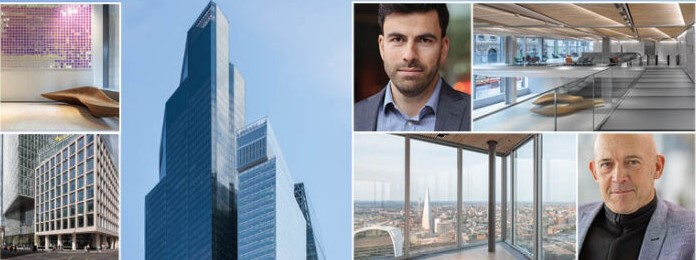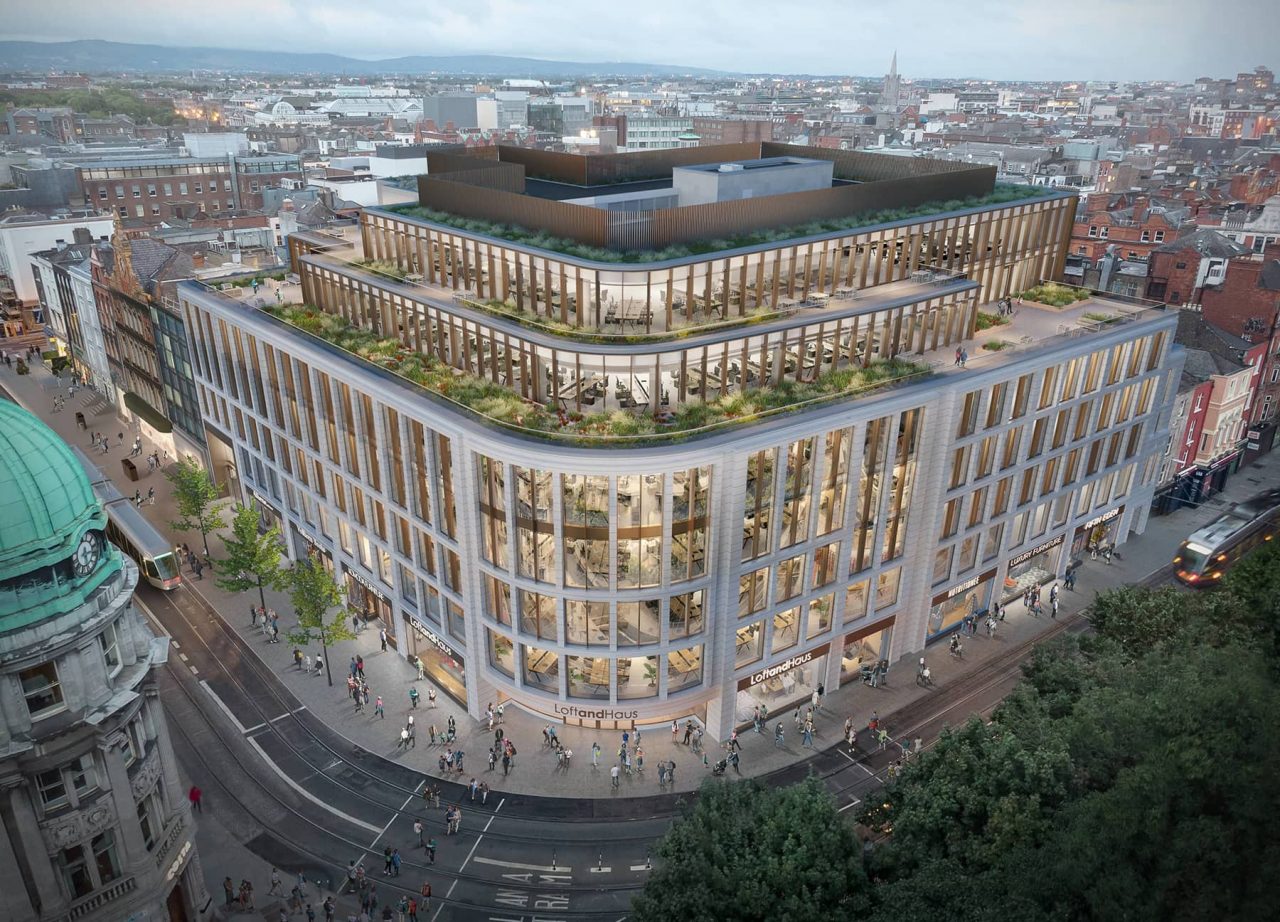News
How 8 Bishopsgate is making its mark on the City

This article was first published on EG on 20th October 2023, Editor: Emily Wright.
Soaring 51 storeys up on the western fringe of the City cluster, 8 Bishopsgate, EC2, has made quite the mark on the London office market since it launched in June. And it is a mark which goes way beyond its physical footprint. Despite being launched in a market where large-scale leasing deals remain under pressure, Stanhope and Mitsubishi Estate’s 913,000 sq ft tower is also proving to be a commercial success.
According to EG Radius, the 50-storey tower has secured more than 196,000 sq ft in leasing deals, with law firm King & Spalding recently agreeing to add a further 41,000 sq ft to that total, making 8 Bishopsgate its new London HQ. And while there is still a significant amount of space to fill, those deals come at a time when the optimism for offices is weak to say the least. Just last month, Jefferies analyst and resident bear Mike Prew downgraded the stock of Landsec, British Land, Derwent and GPE, and predicted a 20% contraction in London office utilisation.
So far, 8 Bishopsgate appears to be bucking that trend. Could its success signal a shift in the office market’s fortunes? Or does a unique aesthetic, a plethora of amenities and being a tech and sustainability trailblazer make 8 Bishopsgate a non- replicable anomaly? Wilkinson Eyre director Oliver Tyler and Kevin Darvishi, Stanhope’s leasing director for the building, shed some light.
Broad tenant mix
“It’s going really well,” says Darvishi of the current leasing figures. “We have a broad mix of insurance, financial and legal occupiers, and a few software and tech companies under offer.” On top of the King & Spalding announcement, it was also revealed last month that law firm Proskauer Rose had taken up four floors across levels 22 to 25, paying around £86 per sq ft.
There have been some hairy moments, though. The timing of the scheme’s build – construction started in March 2019 and ran through the depths of the pandemic – made for a slow start. The first official prelet wasn’t announced until May 2022, just months ahead of completion, when law firm HFW exchanged contracts to lease 62,000 sq ft at around £77 per sq ft.
“It was a bit nerve-racking when certain CEOs were coming out saying ‘we are never going to return to the office’,” says Darvishi. “That hasn’t happened; things picked up.” They picked up to a degree. While the bold statements of 2020 about working from home forever and the death of the office have largely been retracted, the market remains incredibly challenging. That Jefferies report reckons vacancies in the City are around 10% currently: better than the 20% vacancy rate in Canary Wharf, but worse than the 7% in the West End.
Expectations are higher than ever, and the thread now running through almost every conversation about the future of the office is around the importance of offering a space where people actually want to spend their time. Simple to say. Hard and often costly to do. But therein lies the key ingredient to 8 Bishopsgate’s not-so-secret sauce. It gives the people what they want. It’s sustainable, tech-enabled, well designed and stacked full of amenities.
Green to the core
The sustainability credentials are not only a draw for employees, who increasingly want to work in sustainable buildings, but now a massive priority for occupiers and investors who are looking to future-proof their portfolios. When it comes to core green HQ buildings, 8 Bishopsgate is up there. The City’s most sustainable speculative office tower, it targeted and achieved BREEAM Outstanding and is EPC A rated. This is noteworthy given that these sustainability credentials had to be driven through the architecture and construction of the scheme from the outset. Buildings that have previously achieved BREEAM Outstanding have been prelet off-plan. 8 Bishopsgate is the only one to have achieved it in the design. More than 5,000 tonnes of CO2 was saved as a result of architectural innovations during the design and build process.
“The site is assembled from what were two late sixties/early seventies buildings,” says Tyler. “We reused the basements, we reused a lot of the footings. The dark glass we have used is 40% insulated. We have taken some weight out of the structure, which requires fewer footings.
“Then we have also done a lot with the building services systems. Each office floor has an air plant. Most buildings of this scale would have a centralised plant. So if you have a building that is multi-tenant like this, and you have one tenant who has a relationship with a client on the west coast of America and they are here until 1am, then all of the systems would typically be on. Now it can be controlled floor by floor.”
Good for energy efficiency but also a big draw post-Covid, says Darvishi, when occupiers were interested in “their air being their air rather than being circulated around the building and filtered”. The building is crowned with the highest solar panels in London, and data capture gives an overview of the scheme’s energy performance at any given time. It also has a strong focus on biodiversity, largely through its multiple roof terraces.
Wellbeing agenda
The terraces, some extending to 8,000 sq ft and one including a restaurant, bar and lounge open to the whole building, were a core element of the initial design. “It was very much part of our wellbeing agenda to create terraces that people can use,” says Tyler. “So whereas 20 years ago you put all of your building plant on your roof terraces, we were keen to create spaces that people could access.” The stepped design of the tower naturally created three main terraces which “very much informed the way the building looks”, adds Tyler. And the terrace provision has evolved to reflect the way the building was let, adds Darvishi. “If we had someone who had taken 300,000 sq ft of the building, on level 26 we would have happily said ‘that’s your terrace – enjoy it’. When our first major prelets were 60-70,000 sq ft, it gave us an opportunity to create a building facility on that level that anyone can use. It didn’t feel right to give someone who hadn’t taken a very large amount of space access to an 8,000 sq ft terrace. So we designed a kitchen and bar area, and now it is something everyone can enjoy.”
As for the building’s wider amenities, of which there is 75,000 sq ft, a lot of thought has gone into what to provide. There is no gym. “I don’t think people really want to work out next to their colleagues,” laughs Darvishi. Instead, there is a ground-floor public café, basement locker and shower rooms and the 50th-floor viewing platform, which is open to the public but booked up until March 2024. Then there is the auditorium – a carefully researched addition, and one the team is billing as a major draw. The 200-seat auditorium took out around 4,000 sq ft of lettable space. So how does that earn its keep?
“We spoke to a lot of people about auditoriums and what people are lacking when they hold an event,” says Darvishi. “What do they need? A green room, a cloak room, a breakout room. It is a lot of space. But we found the marketing void is reduced as a lot of occupiers are saying ‘I love this facility. I can’t afford to have it in my space, but knowing it is here and that I can use it once a quarter is great.’ So having these facilities has really helped us in our marketing.
“The office is no longer seen as a cost basis but the value-add. People can use a great office to retain their best staff and recruit better staff because they get to come to work somewhere that has a café, an auditorium, meeting rooms, a viewing gallery.”
Top tech
8 Bishopsgate is also tech-enabled to the core, and has been billed as London’s first mobile-only building. Access is on a strictly tap-in-and-out basis, powered by an app developed by tech firm Cureoscity.
Of course, the tech is not just there to elevate the tenant experience. Data is power, and the information fed back on the building’s usage will help when it comes to making management and efficiency decisions. As Darvishi point out, the absence of a centralised plant removes a layer of requirement for whole-building analysis, but the team is looking into how data from the app can be effectively employed to continue to drive efficiency.
It would be remiss not to mention some of the more subtle design details. Tyler’s gentle palette is punctuated by natural timber and stone. The entrance is a showstopper. The space has been described as looking more like a concert hall than an office. Tyler has pulled light into the lift lobbies and staircases to encourage use and make them “joyful places to be”. It is a strategy emulated right up through the building. In terms of creating a space where people want to spend their time and travel to, the work of Stanhope, Mitsubishi Estate and Wilkinson Eyre is paying off. Of course, the team has had the benefit of working with a blank canvas, but there are still applicable lessons to be learnt.
And, says Tyler, there are also green shoots of evidence to suggest the tide may be turning around the office market. “We had been talking to a lot of employers who were questioning how they were going to reconfigure their estate building,” he says. “But from what I can see now, they are starting to reverse this and are saying ‘actually, we don’t want to do that’. There is a definite groundswell of people saying they want to come back.”
More articles
All latest news



